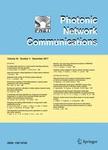版权所有:内蒙古大学图书馆 技术提供:维普资讯• 智图
内蒙古自治区呼和浩特市赛罕区大学西街235号 邮编: 010021

作者机构:Jadavpur Univ Dept Comp Sci & Engn Calcutta 700032 W Bengal India
出 版 物:《PHOTONIC NETWORK COMMUNICATIONS》 (Photonic Netw. Commun.)
年 卷 期:2000年第2卷第2期
页 面:155-161页
核心收录:
学科分类:0810[工学-信息与通信工程] 0809[工学-电子科学与技术(可授工学、理学学位)] 08[工学] 0812[工学-计算机科学与技术(可授工学、理学学位)] 0702[理学-物理学]
基 金:All India Council for Technical Education AICTE
主 题:WDM optical networking routing wavelength assignment lightpath semi-lightpath shortest path algorithm blocking probability
摘 要:This paper deals with the problem of optimal dynamic routing in WDM optical networks with wavelength-changing facilities available at some of the nodes. The route may be either a lightpath (i.e., wavelength continuous channel) or a semi-lightpath (i.e., wavelength-converted channel). We attempt to estimate in this work the gain in blocking probability, when we move from lightpath routing to semi-lightpath routing, keeping the number of wavelengths fixed, in a given circuit switched network. We ensure optimal (minimum cost) routing in both the cases by using the algorithm of Banerjee et al. [7,8] (called Algorithm-I in this paper) for lightpaths and that of Chlamtac et al. [6] (called Algorithm-II) for semi-lightpaths. Our results indicate that, for both the algorithms, the blocking probability (P-B), as expected, increases with network load. At light load, P-B for Algorithm-I is always larger than that for Algorithm-II. But the rate of increase in P-B is slightly higher in case of Algorithm-II, so that there is a crossover point where P-B for Algorithm-II exceeds P-B for Algorithm-I. This probably happens due to the irregularities in the semi-lightpaths at heavy loads when almost all routes are exhausted in the network. However, since this crossover phenomenon occurs at a very congested status of the network, it has little significance over the real life operation of a network. It only suffices to indicate that, under heavy load, both the algorithms are equally insufficient, and conversion does not improve the situation as might have been expected intuitively.